

Compact Muon Solenoid
LHC, CERN
| CMS-HIN-18-016 ; CERN-EP-2020-032 | ||
| The production of isolated photons in PbPb and pp collisions at ${\sqrt {\smash [b]{s_{_{\mathrm {NN}}}}}} = $ 5.02 TeV | ||
| CMS Collaboration | ||
| 28 March 2020 | ||
| JHEP 07 (2020) 116 | ||
| Abstract: The transverse energy ($E_{\mathrm{T}}^{\gamma}$) spectra of photons isolated from other particles are measured using proton-proton (pp) and lead-lead (PbPb) collisions at the LHC at ${\sqrt {\smash [b]{s_{_{\mathrm {NN}}}}}} = $ 5.02 TeV with integrated luminosities of 27.4 pb$^{-1}$ and 404 $\mu$b$^{-1}$ for pp and PbPb data, respectively. The results are presented for photons with 25 $ < E_{\mathrm{T}}^{\gamma} < $ 200 GeV in the pseudorapidity range $|{\eta}| < $ 1.44, and for different centrality intervals for PbPb collisions. Photon production in PbPb collisions is consistent with that in pp collisions scaled by the number of binary nucleon-nucleon collisions, demonstrating that photons do not interact with the quark-gluon plasma. Therefore, isolated photons can provide information about the initial energy of the associated parton in photon+jet measurements. The results are compared with predictions from the next-to-leading-order JETPHOX generator for different parton distribution functions (PDFs) and nuclear PDFs (nPDFs). The comparisons can help to constrain the nPDFs global fits. | ||
| Links: e-print arXiv:2003.12797 [hep-ex] (PDF) ; CDS record ; inSPIRE record ; HepData record ; CADI line (restricted) ; | ||
| Figures | |
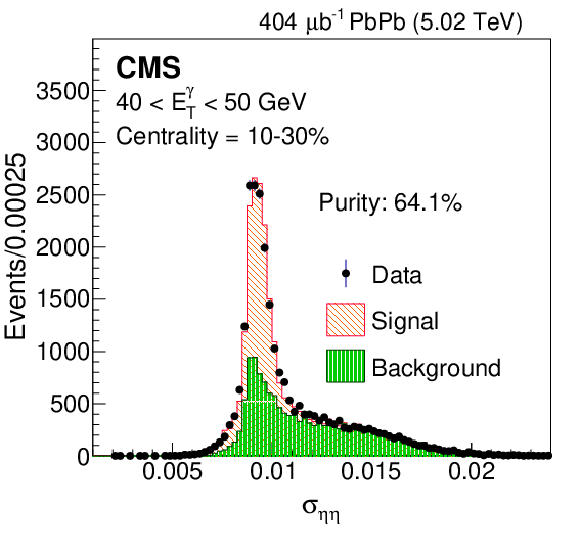
png pdf |
Figure 1:
Template fit of the shower shape variable $\sigma _{\eta \eta}$ for 40 $ < {{E_{\mathrm {T}}} ^\gamma} < $ 50 GeV in the 10-30% centrality class. The black points show the PbPb experimental data. The red histogram is the signal template obtained from PYTHIA+HYDJET simulations, and the green histogram is the background template estimated from the data for the nonisolated sideband region. |
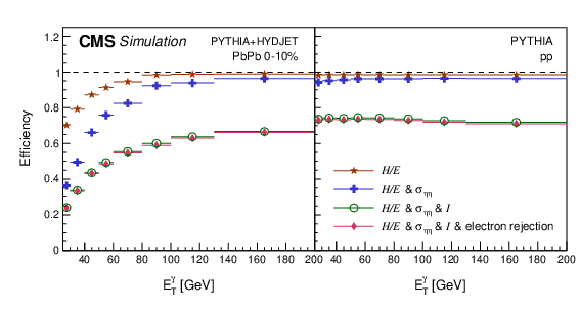
png pdf |
Figure 2:
Efficiency of the isolated photon detection as a function of ${{E_{\mathrm {T}}} ^\gamma}$ for PbPb collisions in the 0-10% centrality range (left) and for pp data (right). The different colors represent various selection criteria. |

png pdf |
Figure 3:
Isolated photon spectra (upper) measured as a function of ${{E_{\mathrm {T}}} ^\gamma}$ for 0-10%, 10-30%, 30-50%, 50-100%, and 0-100% PbPb collisions (scaled by ${T_\mathrm {AA}}$) at 5.02 TeV. The spectra are scaled by the factors shown in the legend for clarity. The symbols are placed at the center of the bin. The vertical bars associated with symbols indicate the statistical uncertainties and the horizontal bars reflect the bin width. Some of the statistical uncertainties are smaller than the symbols. The total systematic uncertainties are shown as boxes in each ${{E_{\mathrm {T}}} ^\gamma}$ bin. The spectra in the 0-100% centrality bin are compared to the NLO JETPHOX calculations with EPPS16+CT14 nPDFs (left) and nCTEQ15 nPDFs (right). The ratio of the data in the 0-100% centrality class to JETPHOX is shown in the lower panels. The gray boxes indicate the total systematic uncertainties of the data. The blue and red hatched boxes correspond to the JETPHOX PDF and scale uncertainties, respectively. |
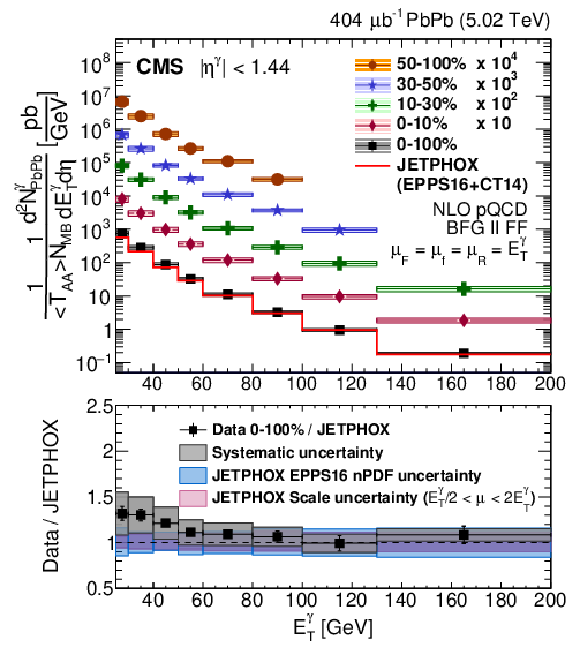
png pdf |
Figure 3-a:
Isolated photon spectra (upper) measured as a function of ${{E_{\mathrm {T}}} ^\gamma}$ for 0-10%, 10-30%, 30-50%, 50-100%, and 0-100% PbPb collisions (scaled by ${T_\mathrm {AA}}$) at 5.02 TeV. The spectra are scaled by the factors shown in the legend for clarity. The symbols are placed at the center of the bin. The vertical bars associated with symbols indicate the statistical uncertainties and the horizontal bars reflect the bin width. Some of the statistical uncertainties are smaller than the symbols. The total systematic uncertainties are shown as boxes in each ${{E_{\mathrm {T}}} ^\gamma}$ bin. The spectra in the 0-100% centrality bin are compared to the NLO JETPHOX calculations with EPPS16+CT14 nPDFs. The ratio of the data in the 0-100% centrality class to JETPHOX is shown in the lower panels. The gray boxes indicate the total systematic uncertainties of the data. The blue and red hatched boxes correspond to the JETPHOX PDF and scale uncertainties, respectively. |

png pdf |
Figure 3-b:
Isolated photon spectra (upper) measured as a function of ${{E_{\mathrm {T}}} ^\gamma}$ for 0-10%, 10-30%, 30-50%, 50-100%, and 0-100% PbPb collisions (scaled by ${T_\mathrm {AA}}$) at 5.02 TeV. The spectra are scaled by the factors shown in the legend for clarity. The symbols are placed at the center of the bin. The vertical bars associated with symbols indicate the statistical uncertainties and the horizontal bars reflect the bin width. Some of the statistical uncertainties are smaller than the symbols. The total systematic uncertainties are shown as boxes in each ${{E_{\mathrm {T}}} ^\gamma}$ bin. The spectra in the 0-100% centrality bin are compared to the NLO JETPHOX calculations with nCTEQ15 nPDFs. The ratio of the data in the 0-100% centrality class to JETPHOX is shown in the lower panels. The gray boxes indicate the total systematic uncertainties of the data. The blue and red hatched boxes correspond to the JETPHOX PDF and scale uncertainties, respectively. |
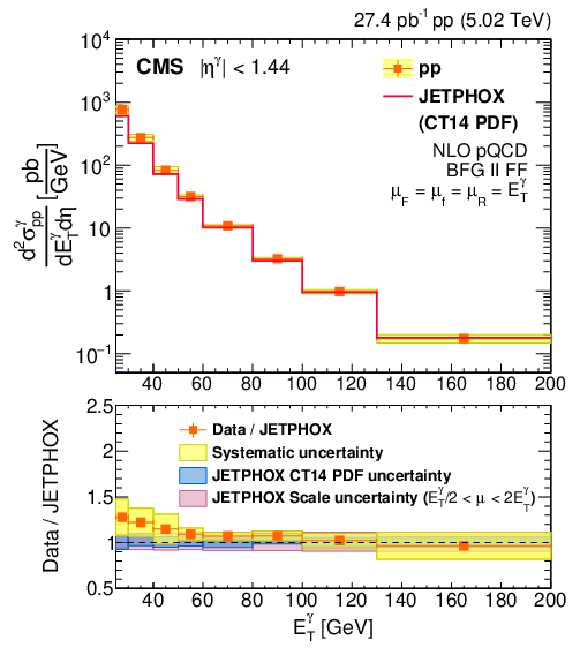
png pdf |
Figure 4:
Isolated photon cross section (upper) measured as a function of ${{E_{\mathrm {T}}} ^\gamma}$ in pp collisions at 5.02 TeV. The symbols are placed at the center of the bin. The vertical bars associated with symbols indicate the statistical uncertainties and the horizontal bars reflect the bin width. Some of the statistical uncertainties are smaller than the symbols. The total systematic uncertainties are shown as boxes in each ${{E_{\mathrm {T}}} ^\gamma}$ bin. The data are compared to the NLO JETPHOX calculations with CT14 PDFs. The ratio of the data to JETPHOX is shown in the lower panel. The yellow boxes indicate the total systematic uncertainties of the data. The blue and red hatched boxes correspond to JETPHOX PDF and scale uncertainties, respectively. |
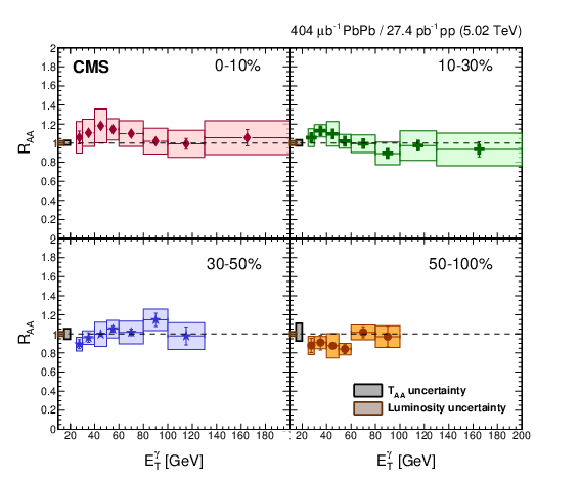
png pdf |
Figure 5:
Nuclear modification factors ${R_{\mathrm {AA}}}$ as a function of the photon ${{E_{\mathrm {T}}} ^\gamma}$ measured in the 0-10%, 10-30%, 30-50%, and 50-100% centrality ranges in PbPb. The symbols are placed at the center of the bin. The vertical bars associated with symbols indicate the statistical uncertainties and the horizontal bars reflect the bin width. The total systematic uncertainties without the ${T_\mathrm {AA}}$ uncertainty are shown as the colored boxes. The ${T_\mathrm {AA}}$ uncertainty, common to all points for a given centrality range, is indicated by the gray box centered at unity on the left side of each panel. The 2.3% integrated luminosity uncertainty for pp data is shown as the brown box at unity at the leftmost position. |
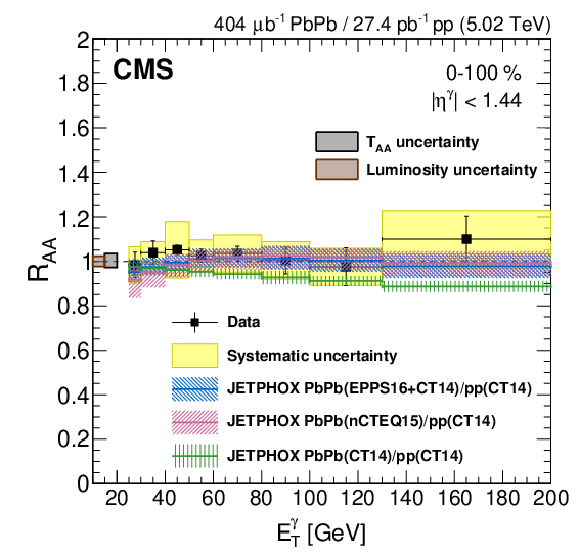
png pdf |
Figure 6:
Nuclear modification factors ${R_{\mathrm {AA}}}$ as a function of the photon ${{E_{\mathrm {T}}} ^\gamma}$ measured in the 0-100% centrality range in PbPb. The symbols are placed at the center of the bin. The vertical bars indicate the statistical uncertainties and the horizontal bars reflect the bin width. The total systematic uncertainties without the ${T_\mathrm {AA}}$ uncertainty are shown by the colored boxes. The 3.4% ${T_\mathrm {AA}}$ uncertainty, common to all points, is indicated by the gray box centered at unity on the left side of the panel. The luminosity uncertainty of the pp data is shown as the brown box at unity at the leftmost position. The three different NLO JETPHOX calculations of EPPS16+CT14 nPDFs, nCTEQ15 nPDFs, and CT14 PDFs for PbPb collisions are divided by the NLO JETPHOX calculations with CT14 PDFs for pp collisions, and compared to the data. The hatched boxes correspond to JETPHOX (n)PDF uncertainties. |
| Tables | |
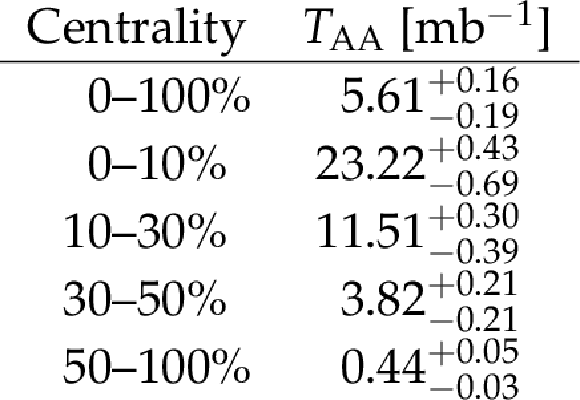
png pdf |
Table 1:
Average numbers of the nuclear overlap function (${T_\mathrm {AA}}$) and their uncertainties for various centrality ranges used in this analysis. |
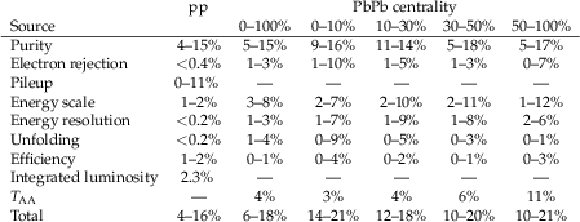
png pdf |
Table 2:
Summary of the contributions from various sources to the estimated systematic uncertainties in the cross section of isolated photons in pp and PbPb collisions. When ranges are shown, they indicate the ${{E_{\mathrm {T}}} ^\gamma}$-dependent variations of the uncertainties. |
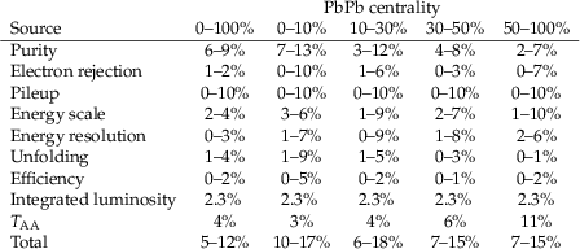
png pdf |
Table 3:
Summary of the contributions from various sources to the estimated systematic uncertainties in the nuclear modification factors calculated from pp and PbPb data. When ranges are shown, they indicate the ${{E_{\mathrm {T}}} ^\gamma}$-dependent variations of the uncertainties. |
| Summary |
|
The differential cross sections of photons isolated from nearby particles are reported at pseudorapidity $|{\eta^{\gamma}}| < $ 1.44 for transverse energy from 25 to 200 GeV in proton-proton (pp) and lead-lead (PbPb) collisions at a center-of-mass energy per nucleon pair ${\sqrt {\smash [b]{s_{_{\mathrm {NN}}}}}} = $ 5.02 TeV with the CMS detector. No significant modification of isolated photon cross sections in PbPb collisions with respect to scaled pp collisions is observed in the explored kinematic ranges at all collision centralities. Thus, isolated photons are not affected by the strongly interacting medium produced in heavy ion collisions, and they can be a valuable tool to access the initial ${p_{\mathrm{T}}}$ of the associated parton in photon+jet events. The data are compared with the next-to-leading order perturbative quantum chromodynamics calculations using the generator JETPHOX with CT14 parton distribution functions (PDFs) for pp data and EPPS16 and nCTEQ15 nuclear PDFs for PbPb data. The predictions are found to be consistent with the cross sections for both pp and PbPb collisions. The current measurements significantly improve the precision compared to the previous CMS results at ${\sqrt {\smash [b]{s_{_{\mathrm {NN}}}}}} = $ 2.76 TeV and can be valuable inputs for global fits of nuclear PDFs. |
| References | ||||
| 1 | F. Karsch and E. Laermann | Thermodynamics and in medium hadron properties from lattice QCD | hep-lat/0305025 | |
| 2 | HotQCD Collaboration | The chiral and deconfinement aspects of the QCD transition | PRD 85 (2012) 054503 | 1111.1710 |
| 3 | W. Busza, K. Rajagopal, and W. van der Schee | Heavy ion collisions: The big picture, and the big questions | Ann. Rev. Nucl. Part. Sci. 68 (2018) 339 | 1802.04801 |
| 4 | CMS Collaboration | Charged-particle nuclear modification factors in PbPb and pPb collisions at ${\sqrt {\smash [b]{s_{_{\mathrm {NN}}}}}} = $ 5.02 TeV | JHEP 04 (2017) 039 | CMS-HIN-15-015 1611.01664 |
| 5 | CMS Collaboration | Measurement of nuclear modification factors of $ \Upsilon $(1S), $ \Upsilon $(2S), and $ \Upsilon $(3S) mesons in PbPb collisions at ${\sqrt {\smash [b]{s_{_{\mathrm {NN}}}}}} = $ 5.02 TeV | PLB 790 (2019) 270 | CMS-HIN-16-023 1805.09215 |
| 6 | CMS Collaboration | Measurement of prompt and nonprompt charmonium suppression in $ \text {PbPb} $ collisions at 5.02 $ \text {Te}\text {V} $ | EPJC 78 (2018) 509 | CMS-HIN-16-025 1712.08959 |
| 7 | CMS Collaboration | Jet shapes of isolated photon-tagged jets in Pb-Pb and pp collisions at ${\sqrt {\smash [b]{s_{_{\mathrm {NN}}}}}} = $ 5.02 TeV | PRL 122 (2019) 152001 | CMS-HIN-18-006 1809.08602 |
| 8 | CMS Collaboration | Observation of medium-induced modifications of jet fragmentation in Pb-Pb collisions at ${\sqrt {\smash [b]{s_{_{\mathrm {NN}}}}}}= $ 5.02 TeV using isolated photon-tagged jets | PRL 121 (2018) 242301 | CMS-HIN-16-014 1801.04895 |
| 9 | CMS Collaboration | Study of jet quenching with isolated-photon+jet correlations in PbPb and pp collisions at $ \sqrt{s_{_{\mathrm{NN}}}} = $ 5.02 TeV | PLB 785 (2018) 14 | CMS-HIN-16-002 1711.09738 |
| 10 | ATLAS Collaboration | Measurement of photon+jet transverse momentum correlations in 5.02 TeV Pb+Pb and $ pp $ collisions with ATLAS | PLB 789 (2019) 167 | 1809.07280 |
| 11 | R. Ichou and D. d'Enterria | Sensitivity of isolated photon production at TeV hadron colliders to the gluon distribution in the proton | PRD 82 (2010) 014015 | 1005.4529 |
| 12 | M. L. Miller, K. Reygers, S. J. Sanders, and P. Steinberg | Glauber modeling in high energy nuclear collisions | Ann. Rev. Nucl. Part. Sci. 57 (2007) 205 | nucl-ex/0701025 |
| 13 | D. de Florian and R. Sassot | Nuclear parton distributions at next-to-leading order | PRD 69 (2004) 074028 | hep-ph/0311227 |
| 14 | M. Hirai, S. Kumano, and T. H. Nagai | Determination of nuclear parton distribution functions and their uncertainties in next-to-leading order | PRC 76 (2007) 065207 | 0709.3038 |
| 15 | F. Arleo, K. J. Eskola, H. Paukkunen, and C. A. Salgado | Inclusive prompt photon production in nuclear collisions at RHIC and LHC | JHEP 04 (2011) 055 | 1103.1471 |
| 16 | CMS Collaboration | Measurement of differential cross sections for inclusive isolated-photon and photon+jets production in proton-proton collisions at $ \sqrt{s} = $ 13 TeV | EPJC 79 (2019) 20 | CMS-SMP-16-003 1807.00782 |
| 17 | CMS Collaboration | Measurement of the differential cross section for isolated prompt photon production in pp collisions at 7 TeV | PRD 84 (2011) 052011 | CMS-QCD-10-037 1108.2044 |
| 18 | CMS Collaboration | Measurement of the isolated prompt photon production cross section in pp collisions at $ \sqrt{s} = $ 7 TeV | PRL 106 (2011) 082001 | CMS-QCD-10-019 1012.0799 |
| 19 | ATLAS Collaboration | Measurement of the inclusive isolated prompt photon cross section in pp collisions at $ \sqrt{s}= $ 8 TeV with the ATLAS detector | JHEP 08 (2016) 005 | 1605.03495 |
| 20 | ATLAS Collaboration | Measurement of the inclusive isolated prompt photons cross section in pp collisions at $ \sqrt{s}= $ 7 TeV with the ATLAS detector using 4.6 fb$ ^{-1} $ | PRD 89 (2014) 052004 | 1311.1440 |
| 21 | ALICE Collaboration | Measurement of the inclusive isolated photon production cross section in pp collisions at $ \sqrt{s} = $ 7 TeV | EPJC 79 (2019) 896 | 1906.01371 |
| 22 | CMS Collaboration | Measurement of isolated photon production in pp and PbPb collisions at ${\sqrt {\smash [b]{s_{_{\mathrm {NN}}}}}}= $ 2.76 TeV | PLB 710 (2012) 256 | CMS-HIN-11-002 1201.3093 |
| 23 | ATLAS Collaboration | Centrality, rapidity and transverse momentum dependence of isolated prompt photon production in lead-lead collisions at ${\sqrt {\smash [b]{s_{_{\mathrm {NN}}}}}} = $ 2.76 TeV measured with the ATLAS detector | PRC 93 (2016) 034914 | 1506.08552 |
| 24 | ATLAS Collaboration | Measurement of prompt photon production in ${\sqrt {\smash [b]{s_{_{\mathrm {NN}}}}}} = $ 8.16 TeV p+Pb collisions with ATLAS | PLB 796 (2019) 230 | 1903.02209 |
| 25 | ALICE Collaboration | Direct photon production in Pb-Pb collisions at ${\sqrt {\smash [b]{s_{_{\mathrm {NN}}}}}} = $ 2.76 TeV | PLB 754 (2016) 235 | 1509.07324 |
| 26 | P. Aurenche et al. | Recent critical study of photon production in hadronic collisions | PRD 73 (2006) 094007 | hep-ph/0602133 |
| 27 | CMS Collaboration | Performance of photon reconstruction and identification with the cms detector in proton-proton collisions at $ \sqrt{s} = $ 8 TeV | JINST 10 (2015) P08010 | CMS-EGM-14-001 1502.02702 |
| 28 | CMS Collaboration | Observation and studies of jet quenching in PbPb collisions at ${\sqrt {\smash [b]{s_{_{\mathrm {NN}}}}}} = $ 2.76 TeV | PRC 84 (2011) 024906 | CMS-HIN-10-004 1102.1957 |
| 29 | CMS Collaboration | The CMS trigger system | JINST 12 (2017) P01020 | CMS-TRG-12-001 1609.02366 |
| 30 | CMS Collaboration | The CMS experiment at the CERN LHC | JINST 3 (2008) S08004 | CMS-00-001 |
| 31 | T. Sjostrand et al. | An introduction to PYTHIA 8.2 | CPC 191 (2015) 159 | 1410.3012 |
| 32 | CMS Collaboration | Event generator tunes obtained from underlying event and multiparton scattering measurements | EPJC 76 (2016) 155 | CMS-GEN-14-001 1512.00815 |
| 33 | I. P. Lokhtin and A. M. Snigirev | A model of jet quenching in ultrarelativistic heavy ion collisions and high-$ p_{\mathrm{T}} $ hadron spectra at RHIC | EPJC 45 (2006) 211 | hep-ph/0506189 |
| 34 | GEANT4 Collaboration | GEANT4 --- a simulation toolkit | NIMA 506 (2003) 250 | |
| 35 | O. Djuvsland and J. Nystrand | Single and double photonuclear excitations in Pb+Pb collisions at ${\sqrt {\smash [b]{s_{_{\mathrm {NN}}}}}}= $ 2.76 TeV at the CERN Large Hadron Collider | PRC 83 (2011) 041901 | 1011.4908 |
| 36 | CMS Collaboration | CMS luminosity calibration for the pp reference run at $ \sqrt{s}= $ 5.02 TeV | CMS-PAS-LUM-16-001 | CMS-PAS-LUM-16-001 |
| 37 | T. C. Awes et al. | A simple method of shower localization and identification in laterally segmented calorimeters | NIMA 311 (1992) 130 | |
| 38 | T. Adye | Unfolding algorithms and tests using RooUnfold | Proceedings, PHYSTAT 2011 Workshop on Statistical Issues Related to Discovery Claims in Search Experiments and Unfolding, CERN, 2011 | 1105.1160 |
| 39 | S. Dulat et al. | New parton distribution functions from a global analysis of quantum chromodynamics | PRD 93 (2016) 033006 | 1506.07443 |
| 40 | K. J. Eskola, P. Paakkinen, H. Paukkunen, and C. A. Salgado | EPPS16: Nuclear parton distributions with LHC data | EPJC 77 (2017) 163 | 1612.05741 |
| 41 | A. K. K. Kovařík et al. | nCTEQ15 - Global analysis of nuclear parton distributions with uncertainties in the CTEQ framework | PRD 93 (2016) 085037 | 1509.00792 |
| 42 | L. Bourhis, M. Fontannaz, and J. P. Guillet | Quarks and gluon fragmentation functions into photons | EPJC 2 (1998) 529 | hep-ph/9704447 |
| 43 | A. Buckley et al. | LHAPDF6: parton density access in the LHC precision era | EPJC 75 (2015) 132 | 1412.7420 |

|
Compact Muon Solenoid LHC, CERN |

|

|

|

|

|

|